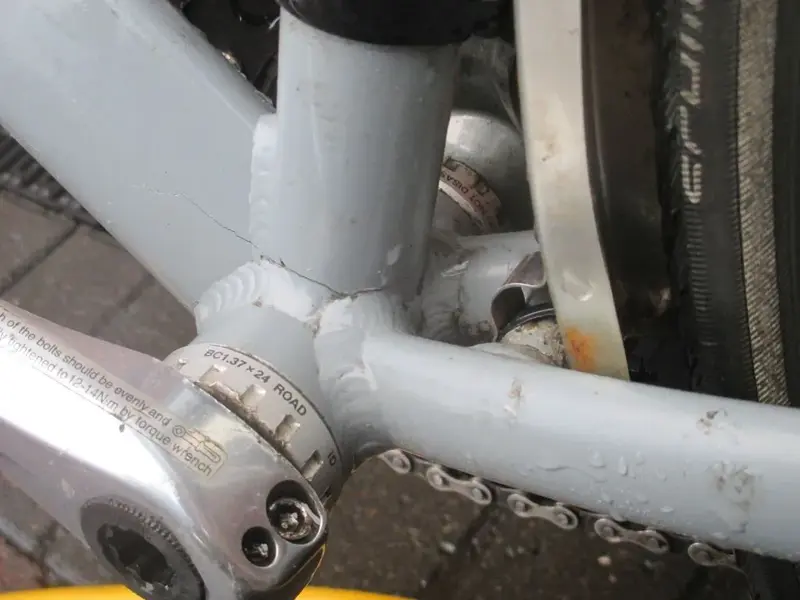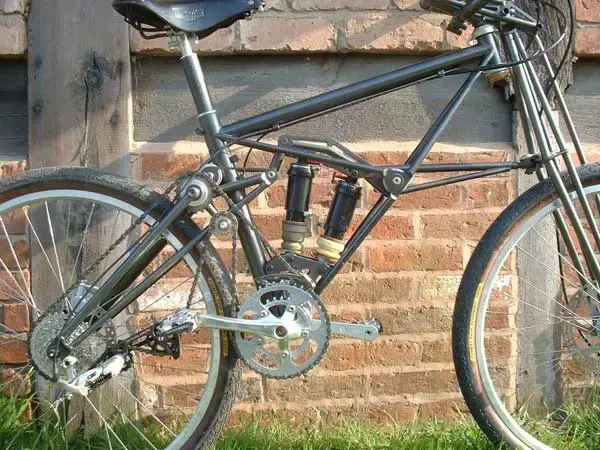You are using an out of date browser. It may not display this or other websites correctly.
You should upgrade or use an alternative browser.
You should upgrade or use an alternative browser.
Ultimate Wet Weather Bike?
- Thread starter Splatter Paint
- Start date
- Feedback
- View
Re: Re:
https://www.flickr.com/photos/38236150@ ... otostream/
https://crosscountrycycle.wordpress.com/
Ideas that could be transferred to a road bike include:
*Stainless steel chain.
*Extra-long mud-flaps to intercept water and grit that is thrown off the the front wheel and onto the chainset, or upwards off the rear wheel onto the riders back or rear paniers etc.
*Chain that runs through tubes or alternatively has guards fitted between the rear wheel and the chain, and one that deflects water/grit from dropping onto the freewheel.
*Shimano Roller-Brakes (Heavy- but completely waterproof because the internals are full of grease).
Additionally, Clelands with suspension have dustproof/waterproof suspension boots and the rear suspension linkage pivots that are sealed with self-amalgamating tape.
Though not intended for riding on a road, this Nexus hub geared is off road bike is to my knowledge the ultimate wet weather off-road bike:bagpuss":2zwfwxw2 said:Does anyone here use a hub gear? for wet weather /commuting . Limited appeal ?
I found this SB article an interesting read .
https://www.sheldonbrown.com/nexus.html
A fellow cyclist swears by his belt drive for soggy rides .
I tend to look at the weather forecast for the week ahead and base my winter riding round it .
This no longer works for me. :roll:
https://www.flickr.com/photos/38236150@ ... otostream/
https://crosscountrycycle.wordpress.com/
Ideas that could be transferred to a road bike include:
*Stainless steel chain.
*Extra-long mud-flaps to intercept water and grit that is thrown off the the front wheel and onto the chainset, or upwards off the rear wheel onto the riders back or rear paniers etc.
*Chain that runs through tubes or alternatively has guards fitted between the rear wheel and the chain, and one that deflects water/grit from dropping onto the freewheel.
*Shimano Roller-Brakes (Heavy- but completely waterproof because the internals are full of grease).
Additionally, Clelands with suspension have dustproof/waterproof suspension boots and the rear suspension linkage pivots that are sealed with self-amalgamating tape.
Re: Re:
Or a full chain case!
pigman":1xoy4k74 said:Shaft drive or belt drive for ultimate weather proofing
Or a full chain case!
- Feedback
- View
Re: Re:
A shaft-drive would need an enclosed crank-case to keep the dirt out and the choice of rear hubs and gears would be very limited.
Full chain-cases are difficult to seal completely and so need to be designed so that water that gets in can easily find its way out. Also, if you want wide-range gearing you either need a suitable hub gear or and enclosed bottom bracket gearbox. Both of these options tend to be heavy and expensive with the later requiring a specialist frame.
Both are far less efficient than even a dirty chain drive. Though a wet belt drive should be more efficient than a dry one because water should reduce the friction between the belt-teeth and the pulleys.pigman":1qfc5bnc said:Shaft drive or belt drive for ultimate weather proofing
A shaft-drive would need an enclosed crank-case to keep the dirt out and the choice of rear hubs and gears would be very limited.
Full chain-cases are difficult to seal completely and so need to be designed so that water that gets in can easily find its way out. Also, if you want wide-range gearing you either need a suitable hub gear or and enclosed bottom bracket gearbox. Both of these options tend to be heavy and expensive with the later requiring a specialist frame.
- Feedback
- View
Re:
Happy New Year RetroBikers :xmas-cool:
For affordable all weather cycling technology look at the equipment used on "public bike-share" bicycles.
These bicycles are left outside in all weathers and so are engineered for high reliability with minimal maintenance.
Some of the components they use need specialist frames but some like the Shimano Nexus components will fit standard frames. Some bicycle manufacturers have used these components to make low-maintenance commuter bikes like the Carrera Subway8.
This is the brake and drivetrain componentry is at the mechanical heart of Geoff Apps' Landseer and TT designs.
Because, Nexus Roller-Brakes are also used on cargo-bikes you can get big diameter versions fitted with large cooling fins. These can cope with the demands of mountain riding even when the bike is fully loaded for long distance touring.
The downside of these components is their high weight and rear wheels can be fiddley to remove because their are no quick-release options for the hub-gears and Roller-Brakes.
Happy New Year RetroBikers :xmas-cool:
For affordable all weather cycling technology look at the equipment used on "public bike-share" bicycles.
These bicycles are left outside in all weathers and so are engineered for high reliability with minimal maintenance.
Some of the components they use need specialist frames but some like the Shimano Nexus components will fit standard frames. Some bicycle manufacturers have used these components to make low-maintenance commuter bikes like the Carrera Subway8.
This is the brake and drivetrain componentry is at the mechanical heart of Geoff Apps' Landseer and TT designs.
Because, Nexus Roller-Brakes are also used on cargo-bikes you can get big diameter versions fitted with large cooling fins. These can cope with the demands of mountain riding even when the bike is fully loaded for long distance touring.
The downside of these components is their high weight and rear wheels can be fiddley to remove because their are no quick-release options for the hub-gears and Roller-Brakes.
vcballbat
Senior Retro Guru
Allen Millard likes to think outside the box and has come up with some ingenious engineering all 'Shed Built' 
https://youtu.be/iUak9sqJmnM
He's built some fantastic motorcycles as well in his other videos..
https://youtu.be/iUak9sqJmnM
He's built some fantastic motorcycles as well in his other videos..
- Feedback
- View
Yes, some very impressive engineering that proves that the mainstream approach is not the only approach that works. Like with Apps, there are a serious number of workshop hours that have gone into making these ground-breaking bikes.vcballbat":3eindpz6 said:Allen Millard likes to think outside the box and has come up with some ingenious engineering all 'Shed Built'
https://youtu.be/iUak9sqJmnM
Back in the 1990's I was involved in a project with David Wrath-Sharman at Highpath Engineering that like the Millyard bikes, used a two chain, high pivot point rear suspension system. D-WS found that centering the middle chainring at the suspension pivot interfered with the rear suspension. The solution was to move the chainring so that the chain ran past the centre of the suspension pivot.
The above suggests that the Millyard bikes, though great for down-hill, are probably not the best when it comes to hill climbing.
The resulting Highpath bicycle ended up being so complex that it is the antithesis of an all weather bicycle.
http://www.toptrail.co.uk/
Attachments
Similar threads
- Replies
- 36
- Views
- 6K
- Replies
- 4
- Views
- 870
- Replies
- 7
- Views
- 842
Latest posts
-
For Sale Cougar SLX frame and Shimano 600 tricolor groupset
- Latest: LondonClassic
-
For Sale cheap Fausto Coppi winter hack thing £60
- Latest: legrandefromage
-
-

